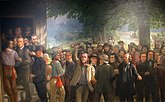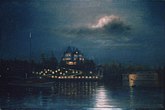User:NNYArtist/sandbox/Theodore Gegoux

American Artist
Theodore Gegoux
Born: November 19, 1850 - St-Clement (Beauharnois), Quebec
Died: July 3, 1931 - Rancho Los Amigos Medical Center, Downey California
Theodore Gegoux was a commercial success as a portrait artist in and around Watertown New York during the latter half of the 19th century. So prolific that by the age of 32 he claimed 1300 completed portraits. By 1890 Gegoux had established himself as, "one of the best oil, pastel, and crayon portrait artists in the city." Fewer in number were his landscapes. He also excelled at still life; his fruits and flowers are highly prized. Marine paintings were another specialty, Gegoux painted both oceans Atlantic and Pacific. He also painted scenes of Lake Ontario and the St. Lawrence River. There are certainly many more works of art, lost works, than have thus far been catalogued. Gegoux was described as “fearless”. He would not shy away from any subject on any media.
William H. Gerdts, 1990, Professor Emeritus of Art History, City University of New York
In addition to working with oil on canvas and crayon on linen backed paper, Gegoux also used many other media and varied subject material. Gegoux once painted a portrait on plate glass which was mounted into a wall like a window to catch the morning sun. He painted flowers on wooden panels. He painted oil on artist board; and he executed still lifes in watercolors on paper. Gegoux was also known to paint unusual subject matter. He once painted a face and features on a walnut carved deer, which had arrived from Bavaria unadorned. His friend wanted Gegoux to “make it look like the picture in the catalog”. Observers claimed the painted carving was indistinguishable from an actual deer mount. Gegoux painted portraits of the deceased from old photos; verbal descriptions; and from views of the corpse. He was often summoned by parents who wanted an image to memorialize their departed child. He painted a pet portrait of his son’s cat “Hims”, oil on canvas. Gegoux painted nocturnal scenes of structure fires. He also painted several doublets, which are two identical portraits, one for each sibling.
Gegoux painted at least three Presidents, although none from life. Lincoln’s portrait survives at the Jefferson County Historical Society, New York. Grant’s portrait was said to have been eight feet tall; it hung at the Watertown Armory the day of Grant’s National Funeral. The Grant portrait was later gifted to the Joe Spratt G.A.R Post at Watertown. President Garfield’s portrait was as a civil war general. Gegoux also painted five other Civil War Generals, although none from life. His portrait of General Meade “being as near perfection as a likeness can be. It almost seems capable of speaking so life-like is the expression and color”. In addition to Meade, Generals Burnside, Hancock, Logan, and McClellan were executed in oil, all sized 4’ x 3’ for the G.A.R. Post.
The acceptance of his “A Young Paganini” 1896 for the First Annual International Carnegie Exhibition at Pittsburgh was the height of his success and fame. But his finest work is seen in a “The Portrait of Two Sisters” 1908, which is a portrait of Agnes Louis Flanders (1905-1979) and Helen Mary Flanders (1903 - 1994) commissioned by their grandfather and executed in oil on canvas. Gegoux’s finest pastel work is the “Keewaydin Mansion in Moonlight” circa 1895. A nocturnal scene in moonlight from the perspective of a boat on the St Lawrence River depicting a once famous home, which was later destroyed by fire. The Mansion once stood on the grounds of what is now the Keewaydin State Park. Although these years in New York were a financial success, Gegoux did not attain any significant notice beyond his local area. He always wanted to join the New York City art scene, but he never got closer than Schenectady.
Seeking a new frontier to revitalize his career, in the fall of 1909 Gegoux secretly left his wife and two grown boys for Oregon. His whereabouts were a mystery to his family and friends for more than two years. Unbeknownst to anyone who knew him, Gegoux had arrived at Portland in early 1910. Finding the “Haunted Castle” vacant, Gegoux chose Piggott’s folly for his residence and studio. Just to be clear, in those days, every resident of Portland knew about the “haunted castle”. Even the 1910 census taker listed this address as the “haunted castle” when they found Gegoux living there. In 1911 Gegoux told an Oregonian reporter at the Haunted Castle, “... I am up here where it is quiet, where no one disturbs me and I can work to the best advantage.” This reporter went on to provide a rare account of the artist’s physical appearance, “Mr. Gegoux is a man below the ordinary size and his hair and mustache are plentifully mixed with the silver that marks the other side of the crest of life. He is very quiet, although he exhibits high nervous temperament that determination and close application to his work has subdued.” The Haunted Castle is where Gegoux started work on the portraits of the “Early Mayors of Portland”; a collection of 29 works; all oil on canvas; all sized 26” by 21”. This collection was completed in 1915 while Gegoux was living in Southern California with his youngest son Frank. Only two of these portraits were individually sold. The remaining collection has been property of the Oregon Historical Society since 1927.
In 1916 the artist returned to Oregon where, guided by George Himes secretary of the Oregon Historical Society, began work on his masterpiece, “The Inception of the Birth of Oregon”. This largest of Gegoux’s work, oil on canvas, measures 80” x 103”. The principle work was finished and copyrighted in 1920. The hand carved frame and date were added in 1923.
The painting composition was informed by discussions with George Himes; it faithfully depicts the so-called “Meek Myth” version of the settlers meeting at Champoeg in May 1843. George Himes and a long list of historians did not think this version a myth. Rather, they believed it to be true history. When it came time to vote, these pioneers were a mass of settlers too unruly to be accurately counted. They were divided into two groups by Joe Meek with a wave of his hat and a call to “divide”. Two French Canadians, F. X. Matthieu and Etienne Lucier, joined the Americans at the last minute to win the vote for organization. This version of events is still hotly debated today. What is not debated is that from the moment of that meeting, that historic vote, Oregon was never again without a civil organization. The Oregonian of December 16, 1900, wrote of the significance of this meeting, “ .. the spirit of those resolute, patriotic, and competent common wealth fathers has fitting expression in an enduring monument.” A granite monument was placed at Champoeg in May 1901. Himes also wanted a painting.
Mr. Himes first revealed his dream for a painting at Champoeg in May 1901 when he stated: “.. the full significance of what has grown out of that gathering of incongruous elements .. Adequately portrayed .. would give a subject for a great historical painting.” Gegoux painted the scene of the pioneer settlers gathered at the McLoughlin Warehouse near the settlement of Champoeg. A warehouse and a town which “hugged too close the banks of the Willamette River for permanence”. Both were lost in the flood waters of 1861.
Gegoux was arguably an unlikely artist for this project; and he chose an equally unlikely location for his studio. Two previous candidates W. H. Gilstrap (1849-1914) and George O’Brien (1853 - 1914) each in turn died before work began. First in 1902, Himes and Gilstrap discussed creating a large canvas scene for the Lewis and Clark exposition of 1905. Trips to Champoeg were conducted and discussions ensued but no paint touched canvas, likely due to a lack of funding. Regarding George O’Brien, as late as 1912 Mr. Himes was still in discussions with this artist who eventually took a portrait commission from the Mayo physicians of Wisconsin, were Mr. O’Brien died. Gegoux was the third artist that Himes had recruited, but the only one to produce the painting.
Gegoux painted under most challenging conditions. Few other artists would have chosen a former tavern in the woods within the flood plains of the Willamette River. He painted in a building that was so ill suited a wall had to be knocked out to give the artist a proper perspective of the picture. The historic work was nearly lost to fire, when that “studio” caught fire on a spring morning in 1918, but it was saved from flames, by a young Arthur Jette and his son. Gegoux had wanted a place for his masterpiece in the State Capitol, but the State voted against buying the painting. Which turned out to be a fortunate fate when the Capitol burned, nearly to the ground, in 1935. During this fire the “Birth of Oregon” was safely rolled up at Bekins Moving and Storage in Portland. This historic painting survives and is now exhibited at the Champoeg visitors’ center. His masterpiece reflects the culmination of all this artist’s skill and ability.
Stricken by dementia in his final years, Gegoux is not believed to have painted after 1926.
Gallery
[edit]-
The Inception of the Birth of Oregon, 1923 by T. Gegoux, oil on canvas, 80 ins x 103 ins, exhibited at Visitor's Center, Champoeg State Park, Oregon
-
The Portrait of Two Sisters, 1908, T. Gegoux, oil on canvas, 30 ins x 22 ins, Agnes Louis Flanders (1905-1979) and Helen Mary Flanders (1903 - 1994)
-
Keewaydin Mansion in Moonlight .. circa 1895, T. Gegoux, pastel crayon on paper, 27 ins x 40 ins, exhibited at Keewaydin State Park, Alexandria Bay, New York
-
The Portrait of Hims circa 1901, T. Gegoux, oil on canvas, 14 ins x 12 ins, Private Collection
-
Apple Still Life with Knife, 1902, T. Gegoux, oil on canvas, 6.75 ins x 9.75 ins, Private Collection
-
The Blessing of Wheat at Artois, 1882 copied by Gegoux, oil on canvas, 50.05 ins by 125.5 ins, original by Jules Breton (1827 - 1906)
References
[edit]1. "Oregon Painters, Landscape to Modernism (1859-1959) 2nd Edition", Ginny Allen & Jody Klevit, 2021
2. “Theodore Gegoux Painted the Steamboat St. Lawrence, Who Was He?” by Richard F.
Palmer October 13, 2018 - Thousand Island Life (http://tilife.org/)
3. "A Creative Capitalist" by Boni Shafer, March 25, 2012 - Jefferson County Historical
Society
4. "Davenport Art Reference", Raymond Davenport, 2003-2004
5. "Artists in California, 1786-1940 - 3rd Edition", by Edan Hughes, 2002
6. "The Pacific Northwest Landscape - a painted history" by Kitty Harmon & Jonathan
Rabin, 2001
7. "Oregon Painters, the first hundred years (1859-1959)", Ginny Allen & Jody Klevit, 1999
8. "Record of the Carnegie Institute's International Exhibitions 1896-1996", Peter Hastings Falk, 1998
9. "Artists of the Pacific Northwest, a biographical dictionary", Maria Sharylen, 1993
10. "Art Across America" in 3 volumes, William Gerdts, 1990
11. "19th Century Paintings, Drawings and Watercolors", Christie’s East, October 25, 1988
12. "Champoeg: Place of Transition", J.A. Hussey, 1967
13. "The Autobiography of Theodore Gegoux", Theodore Gegoux, 1926
14. "History of the Oregon Country" in six volumes, Harvey W. Scott, 1924
15. "Catalog of Copyright Entries" by Library of Congress, Copyright Office - 1920
16. "Catalogue, First Annual Exhibition", Carnegie Art Galleries, 1896
17. "The Centennial History of Jefferson County, New York", John Haddock, 1894
18. "Gazetteer of Jefferson County, N.Y. ", Hamilton Child, July 1890






